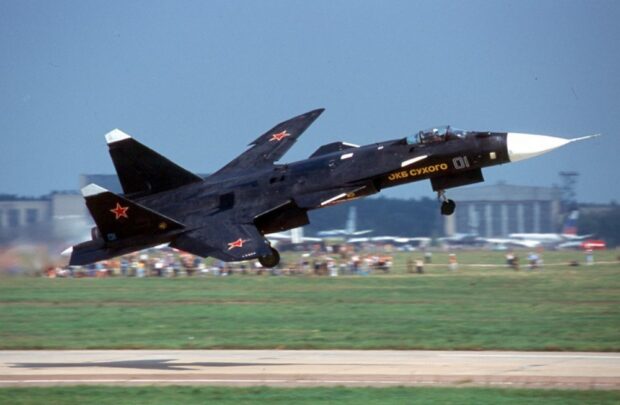The Sukhoi Su-47 Berkut (Russian: Сухой Су-47 Беркут, lit. ’Golden Eagle’) (NATO reporting name Firkin), also designated S-32 and S-37 (not to be confused with the twin-engined delta canard design offered by Sukhoi in the early 1990s under the designation Su-37) during initial development, was an experimental supersonic jet fighter developed by the JSC Sukhoi Company.
A distinguishing feature of the aircraft was its forward-swept wing that gave the aircraft excellent agility and maneuverability. While serial production of the type never materialized and the configuration was not further pursued, the sole aircraft produced served as a technology demonstrator prototype for a number of advanced technologies later used in the 4.5 generation fighter Su-35 and current fifth-generation jet fighter Su-57.
Originally known as the S-37, Sukhoi redesignated its advanced test aircraft as the Su-47 in 2002. Officially nicknamed Berkut (Russian: Беркут) (the Russian word for the golden eagle), the Su-47 was originally built as Russia’s principal testbed for composite materials and sophisticated fly-by-wire control systems, as well as new airframe technologies.
TsAGI has long been aware of the advantages of forward-swept wings, with research including the development of the Tsibin LL and study of the captured Junkers Ju 287 in the 1940s. At high angles of attack, the wing tips remain retracted allowing the aircraft to retain aileron control. Conversely to more conventional rear-swept wings, forward sweep geometrically creates increased angle of incidence of the outer wing sections when the wing bends under load. The wings experience higher bending moments, leading to a tendency for the wings to fail structurally at lower speeds than for a straight or aft-swept wing.
The project was launched in 1983 on order from the Soviet Air Force. But when the USSR dissolved, funding was frozen and development continued only through funding by Sukhoi. Like its US counterpart, the Grumman X-29, the Su-47 was primarily a technology demonstrator for future Russian fighters such as the Sukhoi Su-57. The forward-swept wing configuration was ultimately not pursued because it was mainly advantageous at transonic speeds while an aft-swept wing was superior at supersonic speeds.
Sources: Wikipedia; YouTube

